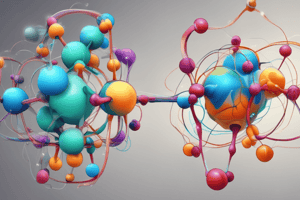Podcast
Questions and Answers
What type of bond is formed through the transfer of electrons from one atom to another?
What type of bond is formed through the transfer of electrons from one atom to another?
- Metallic Bond
- Covalent Bond
- Hydrogen Bond
- Ionic Bond (correct)
Which of the following statements about covalent bonds is true?
Which of the following statements about covalent bonds is true?
- Covalent bonds are typically weaker than ionic bonds.
- Covalent bonds always form double bonds.
- Covalent bonds can involve electron sharing. (correct)
- Covalent bonds form between metals.
What is the bond angle in a tetrahedral molecular geometry?
What is the bond angle in a tetrahedral molecular geometry?
- 120°
- 90°
- 109.5° (correct)
- 180°
Which intermolecular force is the strongest type of dipole-dipole interaction?
Which intermolecular force is the strongest type of dipole-dipole interaction?
Which type of hybridization results in a linear shape with two regions of electron density?
Which type of hybridization results in a linear shape with two regions of electron density?
What property of a bond is influenced by atomic size and bond type?
What property of a bond is influenced by atomic size and bond type?
Which molecular geometry corresponds to an angle of 120°?
Which molecular geometry corresponds to an angle of 120°?
What is characteristic of metallic bonds?
What is characteristic of metallic bonds?
In nonpolar covalent bonds, electron sharing occurs in what manner?
In nonpolar covalent bonds, electron sharing occurs in what manner?
Which type of bond results in the formation of charged ions?
Which type of bond results in the formation of charged ions?
Flashcards are hidden until you start studying
Study Notes
Chemical Bonding
1. Definition
- Chemical bonding is the interaction that holds atoms together in molecules and compounds.
2. Types of Chemical Bonds
-
Ionic Bonds
- Formed through the transfer of electrons from one atom to another.
- Typically occurs between metals (donors) and non-metals (acceptors).
- Results in the formation of charged ions (cations and anions).
- Example: Sodium chloride (NaCl).
-
Covalent Bonds
- Formed by the sharing of electron pairs between atoms.
- Typically occurs between non-metals.
- Can be single, double, or triple bonds depending on the number of shared electron pairs.
- Example: Water (H2O) has single bonds, while oxygen (O2) has a double bond.
-
Metallic Bonds
- Occur between metal atoms where electrons are shared in a "sea of electrons."
- Provides conductivity and malleability to metals.
- Not associated with specific pairs of atoms.
3. Bond Characteristics
-
Bond Length
- Distance between the nuclei of two bonded atoms.
- Influenced by atomic size and bond type.
-
Bond Strength
- Measured in terms of bond dissociation energy.
- Covalent bonds are generally stronger than ionic bonds; metallic bonds vary.
-
Polarity
- Describes the distribution of electrical charge over the atoms in the bond.
- Nonpolar covalent bonds occur when electrons are shared equally (e.g., H2).
- Polar covalent bonds occur when electrons are shared unequally, resulting in partial charges (e.g., HCl).
4. Molecular Geometry
- VSEPR Theory (Valence Shell Electron Repulsion Theory) predicts the shape of molecules based on repulsions between electron pairs.
- Common geometries:
- Linear: 180°, e.g., CO2
- Trigonal planar: 120°, e.g., BF3
- Tetrahedral: 109.5°, e.g., CH4
- Trigonal bipyramidal: 90° and 120°, e.g., PCl5
- Octahedral: 90°, e.g., SF6
5. Hybridization
- The mixing of atomic orbitals to form new hybrid orbitals for bonding.
- Types include:
- sp: Linear (2 regions of electron density)
- sp²: Trigonal planar (3 regions of electron density)
- sp³: Tetrahedral (4 regions of electron density)
6. Intermolecular Forces
- Forces that occur between molecules, influencing physical properties.
- Types include:
- London Dispersion Forces: Weak, occur between all molecules.
- Dipole-Dipole Interactions: Occur between polar molecules.
- Hydrogen Bonds: Strong dipole-dipole interactions involving hydrogen connected to O, N, or F.
7. Importance of Chemical Bonding
- Determines physical and chemical properties of substances.
- Influences reactivity, stability, and phase changes of compounds.
Chemical Bonding
- Definition: The force holding atoms together in molecules and compounds.
- Types:
- Ionic Bonds: Formed by electron transfer between metals (electron donors) and non-metals (electron acceptors), resulting in charged ions. Examples: NaCl.
- Covalent Bonds: Formed by sharing electron pairs between non-metals. Can be single, double, or triple bonds depending on the number of shared pairs. Examples: H2O, O2.
- Metallic Bonds: Occur between metal atoms, where electrons are shared in a "sea of electrons," providing conductivity and malleability.
Bond Characteristics
- Bond Length: Distance between bonded atomic nuclei, influenced by atom size and bond type.
- Bond Strength: Measured by bond dissociation energy, with covalent bonds generally stronger than ionic bonds. Metallic bond strength varies.
- Polarity: Describes the charge distribution over bonded atoms.
- Nonpolar covalent bonds: Equal electron sharing (e.g., H2).
- Polar covalent bonds: Unequal electron sharing, leading to partial charges (e.g., HCl).
Molecular Geometry
- Valence Shell Electron Repulsion (VSEPR) Theory: Predicts molecular shapes based on repulsion between electron pairs.
- Linear: 180°, e.g., CO2.
- Trigonal Planar: 120°, e.g., BF3.
- Tetrahedral: 109.5°, e.g., CH4.
- Trigonal Bipyramidal: 90° and 120°, e.g., PCl5.
- Octahedral: 90°, e.g., SF6.
Hybridization
- Mixing of atomic orbitals to create new hybrid orbitals for bonding.
- sp: Linear (2 electron density regions).
- sp²: Trigonal planar (3 electron density regions).
- sp³: Tetrahedral (4 electron density regions).
Intermolecular Forces
- Attractions between molecules, influencing physical properties.
- London Dispersion Forces: Weak forces present in all molecules.
- Dipole-Dipole Interactions: Occur between polar molecules.
- Hydrogen Bonds: Strong dipole-dipole interactions involving hydrogen bonded to oxygen, nitrogen, or fluorine.
Importance of Chemical Bonding
- Determines physical and chemical properties of substances, influencing reactivity, stability, and phase changes.
Studying That Suits You
Use AI to generate personalized quizzes and flashcards to suit your learning preferences.




